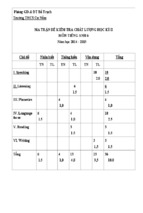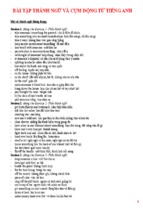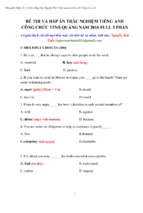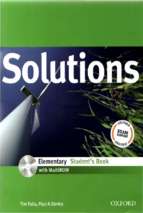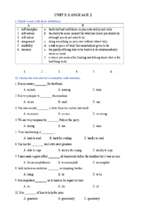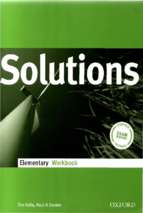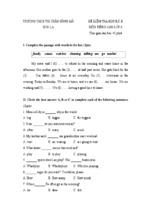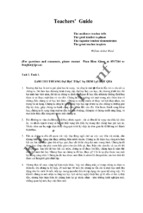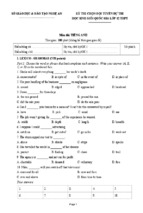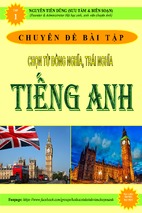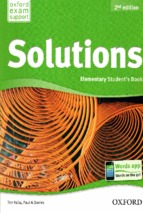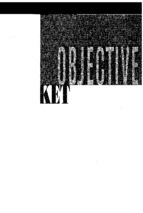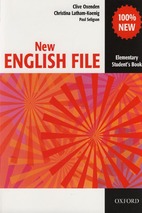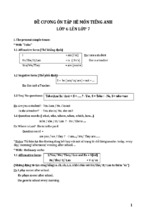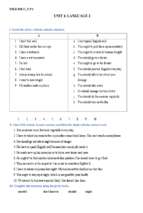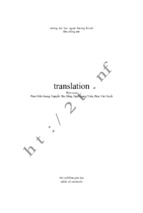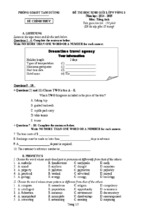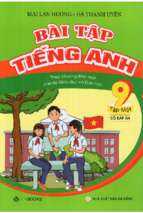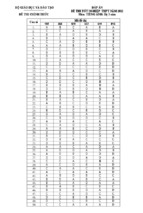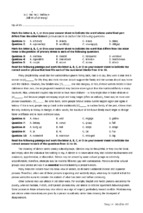www.ebook3000.com
www.ebook3000.com
THE
LITERATURE
BOOK
www.ebook3000.com
www.ebook3000.com
THE
LITERATURE
BOOK
www.ebook3000.com
DK LONDON
SENIOR EDITOR
Sam Atkinson
SENIOR ART EDITOR
Gillian Andrews
original styling by
STUDIO8 DESIGN
produced for DK by
COBALT ID
ART EDITOR
Saffron Stocker
ART EDITORS
Darren Bland, Paul Reid
MANAGING EDITOR
Gareth Jones
EDITORS
Richard Gilbert, Diana Loxley,
Kirsty Seymour-Ure, Marek Walisiewicz,
Christopher Westhorp
MANAGING ART EDITOR
Lee Griffiths
US EDITORS
Jane Perlmutter, Margaret Parrish
ART DIRECTOR
Karen Self
ASSOCIATE PUBLISHING DIRECTOR
Liz Wheeler
PUBLISHING DIRECTOR
Jonathan Metcalf
JACKET DESIGNER
Natalie Godwin
JACKET EDITOR
Claire Gell
JACKET DESIGN DEVELOPMENT MANAGER
Sophia MTT
SENIOR PRODUCER, PRE-PRODUCTION
Tony Phipps
PRODUCER, PRE-PRODUCTION
Nadine King
SENIOR PRODUCERS
Mandy Innes, Rita Sinha
ILLUSTRATIONS
James Graham
DK DELHI
JACKET DESIGNER
Dhirendra Singh
SENIOR DTP DESIGNER
Harish Aggarwal
MANAGING JACKETS EDITOR
Saloni Singh
First American Edition, 2016
Published in the United States by
DK Publishing
345 Hudson Street
New York, New York 10014
Copyright © 2016
Dorling Kindersley Limited
DK, A Division of Penguin Random House LLC
16 17 18 19 20 10 9 8 7 6 5 4 3 2 1
001—274739—March/2016
All rights reserved.
Without limiting the rights under the copyright
reserved above, no part of this publication may be
reproduced, stored in or introduced into a retrieval
system, or transmitted, in any form, or by any means
(electronic, mechanical, photocopying, recording,
or otherwise), without the prior written permission
of the copyright owner.
Published in Great Britain by
Dorling Kindersley Limited.
A catalog record for this book is available
from the Library of Congress.
ISBN: 978-1-4654-2988-9
DK books are available at special discounts when
purchased in bulk for sales promotions, premiums,
fund-raising, or educational use. For details, contact:
DK Publishing Special Markets, 345 Hudson Street,
New York, New York 10014
[email protected]
Printed and bound in China.
A WORLD OF IDEAS:
SEE ALL THERE IS TO KNOW
www.dk.com
www.ebook3000.com
CONTRIBUTORS
JAMES CANTON, CONSULTANT EDITOR
Our consultant and coauthor James Canton
is a lecturer in literature at the University
of Essex, England, where he teaches the
MA “Wild Writing: Literature and the
Environment.” His published work includes
From Cairo to Baghdad: British Travellers in
Arabia (2011) and Out of Essex: Re-Imagining
a Literary Landscape (2013), which explores
the ties between our landscapes and our
selves, delving into the natural world and
its wonders. He is currently writing a tale
about a journey across Britain’s wildest
lands on the trail of prehistoric worlds.
HELEN CLEARY
A nonfiction writer and editor, Helen Cleary
studied English literature at Cambridge
University, England. She went on to complete
the prestigious creative writing MA at the
University of East Anglia, where she was
taught by W. G. Sebald and Lorna Sage. Helen
is a published writer of poetry and short fiction
as well as nonfiction.
ANN KRAMER
A writer and historian, Ann Kramer worked
for various publishers, including DK, before
becoming a full-time writer. Over the years
she has written numerous books for the
general reader on subjects ranging from
art, literature, and the humanities through
to women’s history. Having a deep love of
books and literature, Ann has also taught
adult literacy and literature classes.
ROBIN LAXBY
HILA SHACHAR
NICK WALTON
A freelance editor and writer, Robin Laxby
has a degree in English from Oxford University,
England, and has worked as a publishing
director in London. He has reviewed fiction
for The Good Book Guide and has published
five books of poetry since 1985. The Society
of Authors recently awarded him a grant to
complete a 30,000-word prose poem.
A lecturer in English literature at De Montfort
University, England, and writer for The
Australian Ballet, Hila Shachar has a doctorate
in English literature from The University of
Western Australia. She has published widely
on literature and film, including her New York
Times featured book, Cultural Afterlives and
Screen Adaptations of Classic Literature (2012).
She is also the author of several studies on
the adaptation of literary works, feminism
in literature, and popular and classic fiction.
She is currently writing a monograph on
literary biopics, examining the screen
adaptation of the figure of the author.
Nick Walton is Shakespeare Courses
Development Manager at the Shakespeare
Birthplace Trust in Stratford-upon-Avon,
England. He has written introductory material
for the Penguin editions of Timon of Athens
and Love’s Labour’s Lost, and is coauthor
of The Shakespeare Wallbook. He is also a
contributor to DK’s The Shakespeare Book
in the Big Ideas series.
DIANA LOXLEY
Diana Loxley is a freelance editor and writer,
and a former managing editor of a publishing
company in London, England. She has a
doctorate in literature from the University
of Essex. Her published works include an
analysis of colonial and imperial ideology
in various key texts of 19th-century fiction.
ESTHER RIPLEY
Esther Ripley has a first-class degree in
literature with psychology and has worked
for many years as a journalist, education
magazine editor, book reviewer, and shortstory competition judge. A former managing
editor at DK, she has written books for children
and now writes on a range of cultural subjects.
MEGAN TODD
A senior lecturer in social science at the
University of Central Lancashire, England,
Megan Todd has a degree in English literature
from the University of Aberdeen, Scotland.
She taught English literature at a grammar
school in Cumbria and completed a Masters
in gender studies at Newcastle University,
with a focus on women’s writing.
ALEX VALENTE
A researcher at the University of East Anglia,
England, literary translator, and writer,
Alex Valente has contributed to the Oxford
Companion to Children’s Literature (2015),
the Cultures of Comics Work (2016), and
several smaller poetry and prose publications,
in both Italian and English. He has also taught
first-year English literature modules at the
University of East Anglia.
BRUNO VINCENT
As a former bookseller, then a book editor,
and now a freelance writer, Bruno Vincent
has spent his entire working life around books
and the written word. He is the author of ten
titles, including two Sunday Times top ten
best sellers and two volumes of Dickensian
Gothic horror stories for children.
www.ebook3000.com
MARCUS WEEKS
Marcus Weeks studied music, philosophy, and
musical instrument technology, and had a
varied career, first as a teacher of English as a
foreign language, then a musician, art-gallery
manager, and instrument restorer before
becoming a full-time writer. He has written
and contributed to numerous books on the
humanities, arts, and popular sciences aimed
at making big ideas accessible and attractive,
including many titles in DK‘s Big Ideas’ series.
PENNY WOOLLARD
A theater studies administrator at the
University of Essex, England, Penny Woollard
has a doctorate in literature, from the same
university, titled “Derek Walcott’s Americas:
the USA and the Caribbean.” She has lectured
on Walcott and has also taught American
literature at Essex university.
6
CONTENTS
10 INTRODUCTION
HEROES AND LEGENDS
3000 BCE–1300 CE
20
21
22
26
34
Only the gods dwell forever
in sunlight
The Epic of Gilgamesh
To nourish oneself on
ancient virtue induces
perseverance
Book of Changes, attributed
to King Wen of Zhou
What is this crime I am
planning, O Krishna?
Mahabharata, attributed
to Vyasa
Sing, O goddess, the anger
of Achilles
Iliad, attributed to Homer
How dreadful knowledge
of the truth can be when
there’s no help in truth!
Oedipus the King, Sophocles
47
Real things in the darkness
seem no realer than dreams
The Tale of Genji, Murasaki
Shikibu
72
Laughter’s the property of
man. Live joyfully
Gargantua and Pantagruel,
François Rabelais
48
A man should suffer greatly
for his Lord
The Song of Roland
74
49
Tandaradei, sweetly sang
the nightingale
“Under the Linden Tree,”
Walther von der Vogelweide
As it did to this flower, the
doom of age will blight
your beauty
Les Amours de Cassandre,
Pierre de Ronsard
75
He that loves pleasure must
for pleasure fall
Doctor Faustus, Christopher
Marlowe
76
Every man is the child of
his own deeds
Don Quixote, Miguel de
Cervantes
82
One man in his time plays
many parts
First Folio, William Shakespeare
90
To esteem everything is to
esteem nothing
The Misanthrope, Molière
91
I found myself within a
shadowed forest
The Divine Comedy, Dante
Alighieri
But at my back I always hear
Time’s winged chariot
hurrying near
Miscellaneous Poems,
Andrew Marvell
92
We three will swear
brotherhood and unity of
aims and sentiments
Romance of the Three
Kingdoms, Luo Guanzhong
Sadly, I part from you; like a
clam torn from its shell, I go,
and autumn too
The Narrow Road to the Interior,
Matsuo Bashō
93
None will hinder and none
be hindered on the journey
to the mountain of death
The Love Suicides at Sonezaki,
Chikamatsu Monzaemon
50
52
54
42
Fate will unwind as it must
Beowulf
66
44
So Scheherazade began…
One Thousand and One Nights
Since life is but a dream,
why toil to no avail?
Quan Tangshi
Further reading
1300–1800
62
46
Let another’s wound be
my warning
Njal’s Saga
RENAISSANCE TO
ENLIGHTENMENT
The gates of hell are open
night and day; smooth the
descent, and easy is the way
Aeneid, Virgil
40
He who dares not follow love’s
command errs greatly
Lancelot, the Knight of the Cart,
Chrétien de Troyes
68
Turn over the leef and
chese another tale
The Canterbury Tales,
Geoffrey Chaucer
www.ebook3000.com
7
94
I was born in the Year 1632,
in the City of York, of a
good family
Robinson Crusoe, Daniel Defoe
DEPICTING REAL LIFE
1855–1900
158 Boredom, quiet as the spider,
96
If this is the best of all
possible worlds, what are
the others?
Candide, Voltaire
98
I have courage enough to walk
through hell barefoot
The Robbers, Friedrich Schiller
was spinning its web in the
shadowy places of her heart
Madame Bovary, Gustave
Flaubert
120 Who shall conceive the
horrors of my secret toil
Frankenstein, Mary Shelley
122 All for one, one for all
100 There is nothing more difficult
in love than expressing in
writing what one does not feel
Les Liaisons dangereuses,
Pierre Choderlos de Laclos
102 Further reading
ROMANTICISM AND THE
RISE OF THE NOVEL
1800–1855
The Three Musketeers,
Alexandre Dumas
124 But happiness I never
aimed for, it is a stranger
to my soul
Eugene Onegin, Alexander
Pushkin
finer spirit of all knowledge
Lyrical Ballads, William
Wordsworth and Samuel
Taylor Coleridge
land; I too grew up amid
this scenery
The Guarani, José de Alencar
165 The poet is a kinsman in
the clouds
Les Fleurs du mal, Charles
Baudelaire
166 Not being heard is no reason
for silence
Les Misérables, Victor Hugo
125 Let your soul stand cool
and composed before a
million universes
Leaves of Grass, Walt Whitman
126 You have seen how a man
110 Poetry is the breath and the
164 I too am a child of this
was made a slave; you shall
see how a slave was made
a man
Narrative of the Life of Frederick
Douglass, Frederick Douglass
111 Nothing is more wonderful,
128 I am no bird; and no net
nothing more fantastic than
real life
Nachtstücke, E. T. A. Hoffmann
ensnares me
Jane Eyre, Charlotte Brontë
168 Curiouser and curiouser!
Alice’s Adventures in
Wonderland, Lewis Carroll
172 Pain and suffering are
always inevitable for a large
intelligence and a deep heart
Crime and Punishment, Fyodor
Dostoyevsky
178 To describe directly the life
of humanity or even of a
single nation, appears
impossible
War and Peace, Leo Tolstoy
132 I cannot live without my life!
112 Man errs, till he has ceased
to strive
Faust, Johann Wolfgang
von Goethe
116 Once upon a time…
Children’s and Household Tales,
Brothers Grimm
118 For what do we live, but
to make sport for our
neighbours, and laugh
at them in our turn?
Pride and Prejudice, Jane Austen
I cannot live without my soul!
Wuthering Heights, Emily Brontë
138 There is no folly of the beast
of the Earth which is not
infinitely outdone by the
madness of men
Moby-Dick, Herman Melville
146 All partings foreshadow the
great final one
Bleak House, Charles Dickens
150 Further reading
www.ebook3000.com
182 It is a narrow mind which
cannot look at a subject
from various points of view
Middlemarch, George Eliot
184 We may brave human laws,
but we cannot resist
natural ones
Twenty Thousand Leagues
Under the Sea, Jules Verne
8
185 In Sweden all we do is to
celebrate jubilees
The Red Room, August
Strindberg
BREAKING WITH
TRADITION
1900–1945
186 She is written in a foreign
tongue
The Portrait of a Lady,
Henry James
188 Human beings can be awful
cruel to one another
The Adventures of Huckleberry
Finn, Mark Twain
190 He simply wanted to go
down the mine again, to
suffer and to struggle
Germinal, Émile Zola
192 The evening sun was now
ugly to her, like a great
inflamed wound in the sky
Tess of the d’Urbervilles,
Thomas Hardy
194 The only way to get rid of a
temptation is to yield to it
The Picture of Dorian Gray,
Oscar Wilde
new which must not be
contemplated by men’s eyes
Dracula, Bram Stoker
196 One of the dark places of
the earth
Heart of Darkness, Joseph Conrad
198 Further reading
Awake, wind of dawn!
Berlin Alexanderplatz,
Alfred Döblin
235 Ships at a distance have
208 The world is full of obvious
things which nobody by any
chance ever observes
The Hound of the Baskervilles,
Arthur Conan Doyle
209 I am a cat. As yet I have no
name. I’ve no idea where I
was born
I Am a Cat, Natsume Sōseki
210 Gregor Samsa found himself,
in his bed, transformed into
a monstrous vermin
Metamorphosis, Franz Kafka
212 Dulce et decorum est pro
patria mori
Poems, Wilfred Owen
every man’s wish on board
Their Eyes Were Watching God,
Zora Neale Hurston
236 Dead men are heavier than
broken hearts
The Big Sleep, Raymond Chandler
238 It is such a secret place,
the land of tears
The Little Prince, Antoine de
Saint-Exupéry
240 Further reading
POSTWAR WRITING
1945–1970
213 Ragtime literature which
flouts traditional rhythms
The Waste Land, T. S. Eliot
214 The heaventree of stars hung
195 There are things old and
234 The old world must crumble.
with humid nightblue fruit
Ulysses, James Joyce
222 When I was young I, too,
had many dreams
Call to Arms, Lu Xun
223 Love gives naught but itself
and takes naught but
from itself
The Prophet, Kahlil Gibran
250 BIG BROTHER IS
WATCHING YOU
Nineteen Eighty-Four,
George Orwell
256 I’m seventeen now, and
sometimes I act like I’m
about thirteen
The Catcher in the Rye,
J. D. Salinger
258 Death is a gang-boss aus
Deutschland
Poppy and Memory, Paul Celan
259 I am invisible, understand,
224 Criticism marks the origin of
progress and enlightenment
The Magic Mountain,
Thomas Mann
simply because people
refuse to see me
Invisible Man, Ralph Ellison
260 Lolita, light of my life, fire
228 Like moths among the
whisperings and the
champagne and the stars
The Great Gatsby, F. Scott
Fitzgerald
www.ebook3000.com
of my loins. My sin, my soul
Lolita, Vladimir Nabokov
262 He leaves no stone unturned,
and no maggot lonely
Waiting for Godot, Samuel Beckett
9
263 It is impossible to touch
eternity with one hand
and life with the other
The Temple of the Golden Pavilion,
Yukio Mishima
264 He was beat—the root,
the soul of beatific
On the Road, Jack Kerouac
CONTEMPORARY
LITERATURE
1970–PRESENT
296 Our history is an aggregate
of last moments
Gravity’s Rainbow, Thomas
Pynchon
266 What is good among one
people is an abomination
with others
Things Fall Apart, Chinua
Achebe
270 Even wallpaper has a better
memory than human beings
The Tin Drum, Günter Grass
298 You are about to begin reading
Italo Calvino’s new novel
If on a Winter’s Night a Traveler,
Italo Calvino
300 To understand just one life
you have to swallow the world
Midnight’s Children, Salman
Rushdie
272 I think there’s just one kind
of folks. Folks.
To Kill a Mockingbird,
Harper Lee
276 He had decided to live forever
or die in the attempt
Catch-22, Joseph Heller
thing; claiming ownership
of that freed self was another
Beloved, Toni Morrison
in turmoil
Red Sorghum, Mo Yan
311 You could not tell a story like
this. A story like this you
could only feel
Oscar and Lucinda, Peter Carey
312 A historical vision, the
outcome of a multicultural
commitment
Omeros, Derek Walcott
278 There’s got to be something
wrong with us. To do what
we did
In Cold Blood, Truman Capote
313 I felt lethal, on the verge
of frenzy
American Psycho, Bret
Easton Ellis
280 Ending at every moment but
never ending its ending
One Hundred Years of Solitude,
Gabriel García Márquez
320 Perhaps only in a world of
the blind will things be
what they truly are
Blindness, José Saramago
322 English is an unfit medium
for the truth of South Africa
Disgrace, J. M. Coetzee
324 Every moment happens twice:
inside and outside, and they
are two different histories
White Teeth, Zadie Smith
310 Heaven and Earth were
277 Everyday miracles and the
living past
Death of a Naturalist,
Seamus Heaney
one tiny part of the world
The Wind-Up Bird Chronicle,
Haruki Murakami
306 Freeing yourself was one
274 Nothing is lost if one has the
courage to proclaim that all is
lost and we must begin anew
Hopscotch, Julio Cortázar
319 What we see before us is just
314 Quietly they moved down
the calm and sacred river
A Suitable Boy, Vikram Seth
326 The best way of keeping
a secret is to pretend there
isn’t one
The Blind Assassin, Margaret
Atwood
328 There was something his
family wanted to forget
The Corrections,
Jonathan Franzen
330 It all stems from the same
nightmare, the one we
created together
The Guest, Hwang Sok-yong
331 I regret that it takes a life to
learn how to live
Extremely Loud and Incredibly
Close, Jonathan Safran Foer
332 Further reading
286 Further reading
318 It’s a very Greek idea, and a
profound one. Beauty is terror
The Secret History, Donna Tartt
340 GLOSSARY
344 INDEX
352 ACKNOWLEDGMENTS
INTRODU
CTION
12 INTRODUCTION
S
torytelling is as old as
humanity itself. The tradition
of capturing the events and
beliefs of communities reaches back
to a time when humans first sat by
a fire and told tales. History was
preserved in the form of legends and
mythologies that were passed down
from one generation to the next, and
offered answers to the mysteries of
the universe and its creation.
Written accounts emerged at the
same time as ancient civilizations,
but at first the invention of writing
met simple, prosaic functions—
for example to record transactions
between traders or tally quantities of
goods. The thousands of cuneiform
clay tablets discovered at Ugarit in
Syria reveal the already complex
I begin with writing
the first sentence—and
trusting to Almighty
God for the second.
Laurence Sterne
nature of the written form by
1500 BCE. Writing soon evolved
from a means of providing trading
information, to preserving the oral
histories that were integral to every
culture and their customs, ideas,
morals, and social structures. This
led to the first examples of written
literature, in the epic stories of
Mesopotamia, India, and ancient
Greece, and the more philosophical
and historical texts of ancient China.
As John Steinbeck so succinctly put
it in his Nobel Prize acceptance
speech in 1962: “Literature is as old
as speech. It grew out of human
need for it, and it has not changed
except to become more needed.”
Miss Bingley of Jane Austen’s
Pride and Prejudice may have been
talking fatuously when she declared:
“How much sooner one tires of
anything than of a book!” but
this sentiment rings true for many
of us. Despite the almost limitless
diversions that face readers today,
literature continues to satisfy a
spiritual or psychological need,
and open readers’ minds to the
world and its extraordinary variety.
There are works penned hundreds
of years ago that continue to
enchant and amuse to this day;
complex postmodern texts that
can be challenging in the extreme,
yet still hold us in their grip; and
new novels that feel so fresh that
they read as if words have only
just been invented.
Defining literature
Although the simple definition
of “literature” is “anything that is
written down,” the word has
become primarily associated with
works of fiction, drama, and poetry,
and weighted with the impossibleto-quantify distinction of merit
and superiority. These values are
intrinsic to the canon of literature
drawn upon for academic study and
appreciation that has been evolving
since the middle of the 19th century.
The term “canon” was borrowed
from the ecclesiastical canons
of authorized religious texts.
The literary canon—a collection
of works commonly agreed to be of
exceptional quality—was formed
almost entirely from familiar works
of Western European literature.
Since the mid-20th century,
cultural and literary theorists have
done much to destabilize the canon
by disputing the authority of these
lists of the works of “dead, white
Europeans.” The idea of a perceived
canon of “great works” still stands
as a useful framework, but rather
than the term being used to define
the same set of titles, it evolves
with each new generation, which
INTRODUCTION 13
reexamines the ideology and power
structures that underpin the
selections of previous generations,
and questions why certain other
works were excluded. Arguably,
studying how literature is created
and testing its place in the canon
may help to make us better readers.
In the same spirit, this book features
many titles that are traditionally
regarded as “great works,” but
explores their place in the wider
story of literature, and within a richer
mix of writing drawn from around
the globe. They sit alongside newer
texts that empower some of the
voices that were silenced over the
centuries by social constructs such
as colonialism and patriarchy, and
Europe’s dominance over literature.
Choosing books
This book takes a chronological
journey through literature, using
more than a hundred books as
guideposts along the route. It
also takes a global approach,
exploring literary texts from a
wide range of different cultures
that many readers may not have
encountered previously.
The Literature Book’s chosen
works are either exemplars of a
particular writing style or technique,
or represent a group or movement
that took a new direction, which
was then adopted by other
contemporary writers or expanded
upon by future generations. The
works are arranged chronologically
to highlight the emergence of
literary innovations against the
social and political backdrop of
their times. For example, during
the 17th and 18th century, French
literature evolved from Molière’s
neoclassical comedies of manners
into Voltaire’s satirical undermining
of Enlightenment optimism, and
later into a savage depiction of
decadent French aristocracy shown
in Pierre Choderlos de Laclos’ Les
Liaisons Dangereuses, published
in the lead-up to the French
Revolution. These changes in
literature inevitably overlap as
writers pioneered techniques that
Some books leave us
free and some books
make us free.
Ralph Waldo Emerson
took time to enter the mainstream,
while others continued literary
traditions from previous eras.
Lists are always contentious;
arguably the hundred or so books
chosen here could be replaced
with a hundred others, many
times over. They are not presented
as a definitive list of “must reads,”
instead each work is framed by a
focus or context that is supported
by a timeline of related literary
milestones and events. Crossreferences link to works of a similar
type, or that have influenced or
been influenced by the book under
discussion, while more than 200
titles are listed for further reading,
exploring the literary landscape
of each period in greater detail.
The story of literature
Around 4,000 years ago, the first
stories to be written down came
in the form of poems such as
Mesopotamia’s The Epic of
Gilgamesh and India’s Mahabharata,
which were based on oral traditions.
Rhyme, rhythm, and meter
were essential aids to memory in
songs and oral accounts, so it is
unsurprising that the first texts
made use of familiar poetic devices.
Many early written texts were
religious, and sacred texts such
as the Bible and the Koran tell ❯❯
14 INTRODUCTION
the stories of early histories, and have
influenced writing for centuries.
The form of literature that became
Greek drama used a narrative
balladlike form and introduced
characters with individual voices,
choruses of commentary, and the
distinct categories of comedy and
tragedy that continue to be used
today. The collections of stories that
make up the Arabic One Thousand
and One Nights have multiple
origins, but this prose fiction, written
in plain speech, makes use of
techniques that eventually became a
mainstay in modern novels, such as
framing (which introduces stories
within the framework of another
story), foreshadowing, and the
inclusion of repetitive themes.
Although the vast medieval era
was studded with secular highlights
such as the Anglo-Saxon Beowulf
and tales of chivalric romance, it was
dominated in the West by religious
texts in Latin and Greek. During
the Renaissance, the joint energies
of new philosophical investigation
and sheer invention opened the door
to literary innovation. The driving
force behind the Renaissance was
the production of new translations
of ancient Greek and Roman texts
which freed scholars from the
dogma of the church. A humanist
program of education which
incorporated philosophy, grammar,
history, and languages was built
on the wisdom of the ancients. The
Bible was translated into vernacular
speech, enabling Christians to
commune directly with their God.
Gutenberg’s printing press brought
books into the lives of ordinary
people, and authors such as Geoffrey
Chaucer and Giovanni Boccaccio
made everyday life the subject of
literature. By the early 17th century,
Miguel de Cervantes and Daniel
Defoe had given the world what
many scholars consider to be the
first novels, and the First Folio of
Shakespeare’s plays was published.
The rise of the novel
Drama and poetry continued to
evolve as the novel rose inexorably
in importance, and by the end
A word after a word after
a word is power.
Margaret Atwood
of the 18th century the novel
had become a major form of
literary expression.
Just as artists are described
in terms of movements such as
Baroque and Rococo, so literary
history is defined by authors united
by a particular style, technique, or
location. The Romantic movement,
characterized by stories driven by
the emotions of idiosyncratic heroes,
rather than plot and action, had its
roots in the German Sturm und
Drang movement. Meanwhile,
in England, the Romantic poets
testified to the power of nature to
heal the human soul, and similar
themes were taken up by the
New England Transcendentalists.
The word “genre” was increasingly
applied to fiction’s subsets—for
example, novels in the gothic genre.
In the 19th century, Romanticism
was superseded by a new form of
social realism, played out in the
drawing rooms of Jane Austen’s
English middle and upper classes,
and Gustave Flaubert’s provincial
French towns, but used increasingly
to depict the harsh lives of the poor.
Fyodor Dostoyevsky described his
novel Crime and Punishment as
“fantasy realism,” and the dark
interior monologues of the murderer
Raskolnikov have the elements of a
psychological thriller. Over the years,
INTRODUCTION 15
fiction has diversified into multiple
genres and subgenres, which today
include everything from dystopian
novels to fictional autobiography
and Holocaust writing.
Alongside the growth of the
novel, the vocabulary of literature
expanded to describe styles of
writing: for example, “epistolary”
novels were written in the form of
letters; and “Bildungsroman” and
“picaresque” denoted coming-of-age
tales. The language used within
literature was developing too, and
novels in the vernacular voice
broadened the scope of national
literature with writers such as
Harriet Beecher Stowe and Mark
Twain capturing the diversity of
the people of the US.
In the early 20th century,
Western society was revolutionized
by industrial and technological
advances, new artistic movements,
and scientific developments. Within
two decades, a generation of young
men had been wasted in World
War I. A perfect storm of literary
experimentation followed, as
Modernist writers searched for
inventive stylistic features such
as stream-of-consciousness writing,
and wrote fragmented narratives
representing the anguish and
alienation of their changing world.
After a brief period of literary
optimism and experimentation,
the world was again thrown into
turmoil as World War II began, and
the production of literature slowed
as many writers became involved
in the war effort, and produced
propaganda or reported from the
front rather than writing literature.
The global explosion
After two brutal global wars,
the world was ready for change,
and literature was central to the
counterculture in the West of the
1950s and ’60s. Postmodernist
writers and theorists focused on
the artifice of writing, demanding
more of the reader than simply
engaging with a realist narrative.
Novels now had fractured or
nonlinear time spans, unreliable
narrators, episodes of magical
realism, and multiple-choice
endings. During this period, the
West, and in particular writing
in English, also loosened its grip
on world culture. Postcolonial
writing emerged in countries such
as Nigeria, South Africa, and India,
and authors such as Gabriel García
Márquez helped raise the status of
a group of South American writers
of extraordinary creativity.
Modern literature now sings with
the previously unheard voices of
feminists, civil rights campaigners,
gay people, black and Native
Americans, and immigrants.
There is a healthy meritocratic
blurring of distinction between
classic and popular fiction.
Global publishing, independent
and internet publishing, global
literature courses, national and
international book prizes, and
the growing number of works
published in translation are
bringing Australian, Canadian,
South African, Indian, Caribbean,
and modern Chinese novels, among
others, to a world audience. This
vast library of global literature has
become both a reminder of shared
connections worldwide and a
celebration of difference. ■
Reading is the sole
means by which we slip,
involuntarily, often helplessly,
into another’s skin, another’s
voice, another’s soul.
Joyce Carol Oates
HEROES
LEGEND
3000 –
BCE
1300 CE
AND
S
18 INTRODUCTION
The earliest known texts,
in the Sumerian language,
are written on tablets in
Abu Salabikh, southern
Mesopotamia.
King Wen of Zhou
writes a commentary
on an ancient method
of divination, which is
later expanded into the
Book of Changes (the
Yijing or I Ching).
The ancient Greek epic
poems Iliad and Odyssey,
ascribed to Homer,
are written.
The adoption
of a democratic
constitution by
the Greek city-state
of Athens ushers in
the classical era.
C.2600 BCE
12TH–11TH CENTURY BCE
C.8TH CENTURY BCE
508 BCE
FROM
2100 BCE
The Epic of Gilgamesh is
one of the world’s earliest
examples of written
literature.
S
ystems of writing were
first used as a means of
recording administrative
and commercial transactions.
Gradually, these systems became
more advanced, preserving ancient
wisdom, historical records, and
religious ceremonies, all of which
had previously been memorized
and were passed down orally.
Throughout the world's early
civilizations, in Mesopotamia,
China, India, and Greece, the
written canon of literature first
emerged as history and mythology.
The form that this earliest
literature took was a long narrative
poem, known as an epic, which
focuses on the legends surrounding
a great warrior or leader, and his
battles to protect his people from
their enemies and the forces of
evil. The combination of historical
9TH–4TH CENTURIES BCE
551–479 BCE
5TH CENTURY BCE
The great
Sanskrit epic poems
Mahabharata and
Ramayana are
composed in
ancient India.
The Chinese
philosopher Kong
Fuzi (Confucius) is
active teaching and
compiling the
Five Classics.
The tragedians
Aeschylus,
Euripides, and
Sophocles compete
for the title of greatest
dramatist of Athens.
events and mythical adventures,
told in a metrical verse form,
explained the people's cultural
inheritance in an exciting and
memorable way.
Tales of gods and men
The first known epics, which
include the various versions of The
Epic of Gilgamesh, and the great
Sanskrit epics Mahabharata and
Ramayana, often tell of the origin of
a civilization, or a defining moment
in its early history. Seen through
the exploits of a heroic individual
or a ruling family, these epics also
explained the involvement of the
gods, often contrasting their
powers with the frailties of human
heroes. This was a theme that also
appeared in the later epics ascribed
to Homer. His heroes Achilles and
Odysseus are depicted not only
www.ebook3000.com
as noble warriors in the Trojan War
that established ancient Greece
as a great power, but also as very
human characters confronting both
fate and their own weaknesses.
Later, as Greek influence declined,
Roman poets developed their own
Latin version of the form, even
borrowing the story of the Trojan
War, as Virgil did in the Aeneid,
to produce an epic of the beginning
of Rome. The scale and depth of
Homer’s epics, and their poetic
structure, provided the foundation
on which Western literature is built.
Greek drama
Another product of the tradition
of storytelling in ancient Greece
was drama, which developed from
recounting a narrative to acting out
the part of a character and thereby
bringing the tale to life. Gradually,

